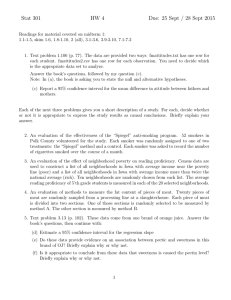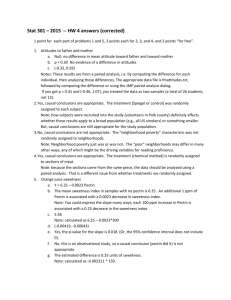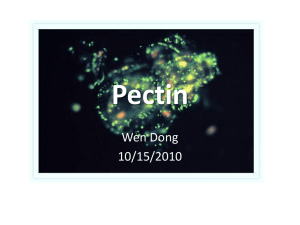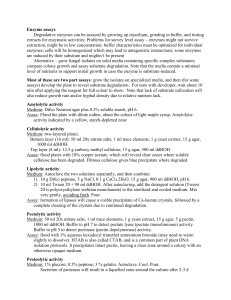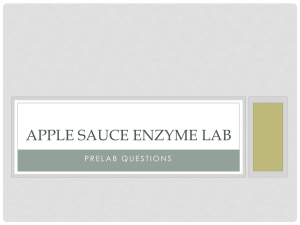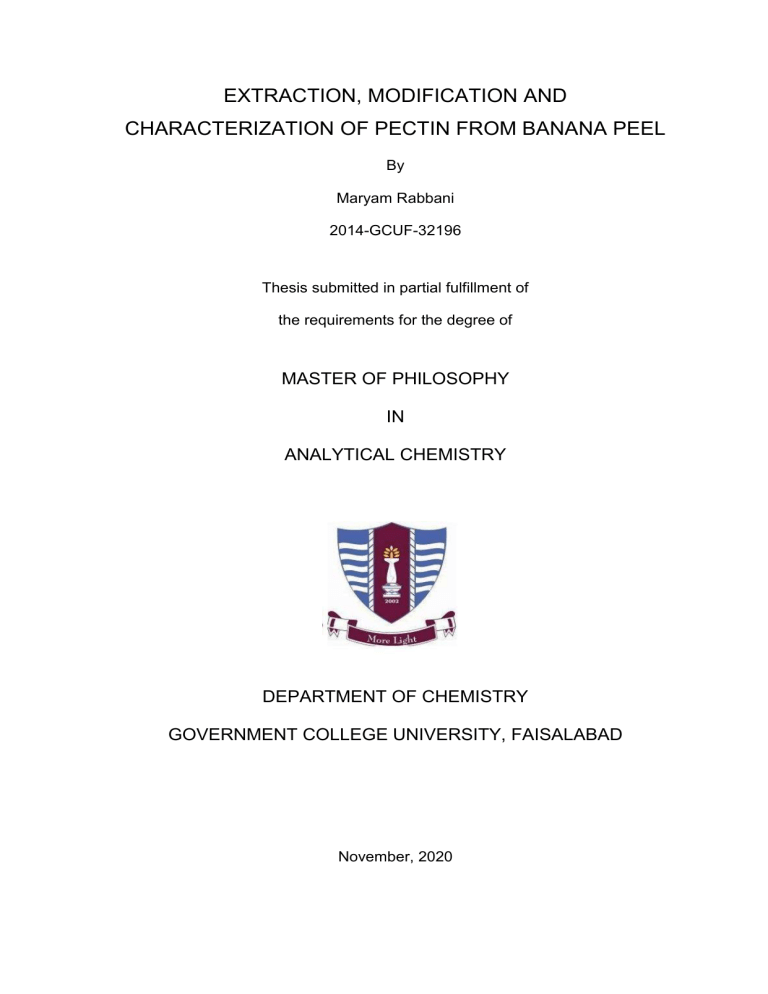
EXTRACTION, MODIFICATION AND CHARACTERIZATION OF PECTIN FROM BANANA PEEL By Maryam Rabbani 2014-GCUF-32196 Thesis submitted in partial fulfillment of the requirements for the degree of MASTER OF PHILOSOPHY IN ANALYTICAL CHEMISTRY DEPARTMENT OF CHEMISTRY GOVERNMENT COLLEGE UNIVERSITY, FAISALABAD November, 2020 DEDICATION Every challenging work needs self-efforts as well as guidance of elders especially those who are very close to our heart. My humble effort I dedicate to my Worthy Parents Whose affection, love, encouragement and prayers of day and night make me able to get such success and honor Along with all hard working and respected Teachers ⅰ DECLARATION The work reported in this thesis was carried out by me under the supervision of Dr. Shahzad Ali Shahid Chatha, Associate Professor, Department of Chemistry, Government College University Faisalabad, Pakistan. I hereby declare that the title of thesis “Extraction, modification and characterization of pectin from banana peel” and the contents of thesis are the product of my own research and no part has been copied from any published source (except the references, standard mathematical of genetic models/equations/formulas/protocols etc). I further declare that this work has not been submitted for the award of any other degree/diploma. The University may take action if the information provided is found inaccurate at any stage. __________________ Maryam Rabbani 2014-GCUF-32196 ⅰ CERTIFICATE BY THE SCRUTINY COMMITTEE It is certified that the thesis submitted by Maryam Rabbani, Registration No. 2014GCUF-32196 is according to prescribed format of the Government College University Faisalabad. 1. Dr. Shahzad Ali Shahid Chatha /Associate Professor ____________ Convener of Scrutiny Committee 2. Dr. Atta ul Haq /Associate Professor ____________ Member of Scrutiny Committee 3. Dr. Fozia Anjum /Assistant Professor Member of Scrutiny Committee ⅰ ____________ CERTIFICATE BY THE RESEARCH SUPERVISORY COMMITTEE It is certified that the contents and form of a thesis submitted by Maryam Rabbani, Registration No. 2014-GCUF-32196 has been satisfactory and in accordance with the prescribed format. We recommend it to be processed for the evaluation by the external examiner for the award of a degree. Supervisor __________________________________ Dr. Shahzad Ali Shahid Chatha Associate Professor Department of Chemistry, GCUF Member of supervisory committee __________________________________ Dr.Syed Ali Raza Naqvi Associate Professor Department of Chemistry, GCUF Member of supervisory committee __________________________________ Prof. Dr. Shazia Anwar Bukhari Professor Department of Biochemistry, GCUF Chairperson __________________________________ Dr. Muhammad Zubair Associate Professor, Chairman Department of Chemistry, GCUF Dean __________________________________ Prof. Dr. Farhat Jabeen Dean Faculty of Physical Sciences Government College University Faisalabad ⅰ TABLE OF CONTENTS Contents Page Number Acknowledgments i List of abbreviations ii List of figures iii List of tables v Abstract vi Chapter 1 Introduction 1 Chapter 2 Review of Literature 5 2.1 Overview of pectin 5 2.2 Chemistry of pectin 6 2.3 Classification of pectin 8 2.3.1 Native pectin 8 2.3.2 Commercial pectin 9 2.3.3 High methoxy pectin 9 2.3.4 Low methoxy pectin 9 2.4 Properties of pectin 10 2.4.1 Gelling properties 10 2.4.2 Emulsifyning properties 10 2.4.3 Solubility 10 2.5 Applications of pectin 11 2.6 Biological properties of pectin 13 2.6.1 Antioxident activity of pectin 13 2.6.2 Antibacterial activity of pectin 15 2.6.3 Antifungal activity of pectin 15 2.6.4 Antitumor activity of pectin 16 2.6.5 Anti-inflammatory activity of pectin 17 2.6.6 Anticancer activity of pectin 17 2.7 Sources of pectin 18 2.8 Extraction methods of pectin 19 2.8.1 Acid extraction 19 2.8.2 Microwave assisted extraction 21 2.8.3 Ultrasound assisted extraction 22 ⅰ 2.8.4 Thermo mechanical extraction 22 2.8.5 Enzymatic extraction 22 2.9 Drawbacks of native pectin 24 2.10 Modification methods of pectin 24 2.10.1 Chemical modification 25 2.10.2 Biological modification 28 2.10.3 Physical modification 29 2.11 Characterization techniques for pectin 31 2.11.1 Fourier transform infrared spectroscopy 31 2.11.2 Atomic force microscopy 31 2.11.3 Scanning electron microscopy 31 2.11.4 Thermal analysis 32 2.11.5 X-ray diffraction 32 2.11.6 High performance exclusion 32 chromatography 2.11.7 Mass spectroscopy Chapter 3 Materials and Methods 33 35 3.1 Chemicals and reagents 35 3.2 Collection and pretreatment of plant material 36 3.3 Preparation of crude extract 36 3.4 Phytochemical screening of fruit aqueous extract 36 3.4.1 Carbohydrate 37 3.4.2 Proteins 37 3.4.3 Flavonoids 38 3.4.4 Phenols 38 3.4.5 Free amino acids 38 3.5 Extraction of pectin 38 3.6 Chemical analysis of pectin 40 3.6.1 Total phenolic contents 40 3.6.2 Total flavonoid contents 40 3.7 Modification of pectin 41 3.8 Characterization for pectin 41 ⅰ 3.8.1 FTIR analysis 41 3.8.2 XRD analysis 41 3.10.3 SEM and EDX analysis 41 3.9 Antioxidant activities 42 3.9.1 DPPH radical antioxidant assay 42 3.9.2 Hydroxyl radical antioxidant assay 42 3.9.3 Ferric reducing antioxidant power 43 3.9.4 Phospho molybdenum phosphate assay 43 3.10 Statistical analysis 43 Chapter 4 Results and Discussion 44 4.1 Extraction yield 44 4.2 Phytochemical screening of fruit aqueous extract 44 4.2.1 Carbohydrate 44 4.2.2 Flavonoids 45 4.2.3 Phenols 45 4.2.4 Proteins 45 4.2.5 Free amino acids 45 4.3 Chemical analysis 46 4.3.1 total flavonoid content 46 4.3.2 Total phenolic content 47 4.4 Modification Yield 48 4.5 Characterization techniques 48 4.5.1 FTIR analysis 48 4.5.2 SEM analysis 49 4.5.3 EDX analysis 50 4.5.4 XRD analysis 51 4.6 Antioxidant activities 52 4.6.1 DPPH radical scavenging assay 52 4.6.2 Ferric reducing antioxidant power 54 4.6.3 Hydroxyl scavenging activity assay 55 4.6.4 Phosphomolybdenum antioxidant assay 57 Summary 59 References 60 ⅰ ACKNOWLEDGMENTS I have only pearls of my eye to admire the blessing of the compassionate and omnipotent because word are bound. Knowledge is limited and time is short to express His dignity, ALMIGHTY ALLAH, the propitious, the benevolent and sovereign Whose Blessing and Glory flourished my thoughts and thrived my ambitions, giving me affectionate parents, talented teachers, sweet brother and unique friends. Trembling lips and wet eye praise for HOLY PROPHET HAZRAT MUHAMMAD (P.B.U.H) for enlightening our conscience with the essence of faith in ALLAH, converging all His kindness and mercy upon him. The work presented in this manuscript was accomplished under the sympathetic attitude, scholarly criticism, cheering perspective and enlightening supervision of Prof. Dr. Shahzad Ali Shahid Chatha, Associate Professor, Department of Chemistry, GC University Faisalabad, Pakistan. I would like to express my gratitude to my research supervisor for their guidance and advice given throughout the course of this work. Without his kind help, the timely completion of my research work would have not possible for me. I expressed my deep sense of gratitude to Dr. Zubair, Chairman, Department of chemistry, GC University, Faisalabad for his generous guidance, inspiring discipline, sincere and unprecedented leadership as well as moral patronization. Friends are there comrades of the battle, the battle to generate knowledge, sift myths and fact and to remove ambiguity. Not least of all, I owe so much to my whole family specially my parents and my beloved brother Engr. M. Abdullah Khan for my success is really the fruit of their devoted prayers. Also for their undying support, their unwavering belief that I can achieve. Unfortunately, I cannot thank everyone by name because it would take a lifetime but, I just want you all to know that you count so much. Had it not been for all your prayers and benedictions, were it not for your sincere love and help, I would never have completed this thesis. So, thank you all. (Maryam Rabbani) ⅰ LIST OF ABBREVIATIONS Symbol Abbreviations LMP Low mthoxy pectin HMP High methoy pectin DPPH 2,2-diphenyl -1picrylhydrazyl FRAP Ferric reducing antioxidant power HPLC High performance liquid chromatography SEM Scanning electron microscopy XRD X-ray diffractometry EDX Energy dispersive xray ANOVA Analysis of Variance SD Standard deviation ⅰ LIST OF FIGURES Figure Page Number Figure 2.1: Structure of pectin 5 Figure 3.1: Schematic diagram of methadology 35 Figure 3.2: Pretreatment of plant material 36 Figure 3.3: Schematic diagram of extracion 39 Figure 3.4: Chemical analysis of pectin 40 Figure 4.1: Standard curve of gallic acid 47 Figure 4.2: Standard curve of quercetin 47 Figure 4.3: FTIR spectra of native pectin 49 Figure 4.4: FTIR spectra of modified pectin 49 Figure 4.5: SEM spectra of native pectin 50 Figure 4.6: SEM spectra of modified pectin 50 Figure 4.7: EDX spectrum of native pectin 51 Figure 4.8: EDX spectrum of modified pectin 51 Figure 4.9: XRD spectra of native pectin 52 Figure 4.10: XRD spectra of modified pectin 52 Figure 4.11: scavenging actity of DPPH 54 Figure 4.12: Scavenging activity of FRAP 55 Figure 4.13: Scavenging activity of hydroxyl assay 56 Figure 4.14: Scavenging activity of Phosphomolybdenum assay 58 ⅰ LIST OF TABLES Table Page Number Table 1: Different sources of extraction 19 Table 2: Different modes of extraction 23 Table 3: Yield of extracted pectin 44 Table 4: Phytochemical screening test results 46 Table 5: DPPH radical scavenging antioxidant assay 53 Table 6: FRAP radical scavenging antioxidant assay 55 Table 7: Hydroxyl scavenging antioxidant assay 56 Table 8: Phospho molybdenum assay 57 ⅰ ABSTRACT Pectin having the properties like low cost, local availability, biodegradability and nontoxic behaviors gaining attention for biomedical applications. Banana peel is a rich source of pectin. The present study was aimed to extract the pectin from banana peel. In this study the pectin was extracted from the banana peel and modified by one of the chemical methods. Pectin extraction was done by using acid based extraction method. Characterization techniques such as FTIR was used to determine the functional groups on the structure of pectin. The surface morphology, elemental composition and crystalline structure will be determined by SEM, EDX and XRD. The biological applications like anti-oxidant will be comparatively analyzed of native and modified pectin with the help of reported methods. The modification of natural pectin extracted from banana peel enhanced the anti-oxidant activities. ⅰ Chapter 1 INTRODUCTION Natural products obtained from plants, animals, microorganisms and marine have been used for maintenance of natural life in both native as well as the modified form from the beginning of human life (Wardropper et al., 2020). They play a vital role in the sustainability of life by curing the several disorders either appeared in the environment or in human and animal life (Arshad et al., 2011). Plants based natural products have been gaining special attention to researchers, herbalists and industrialists. Especially, natural products from medicinal plants have to turn out to be a natural source of medicine to treat several kinds of human and animal diseases (Abbas et al., 2011; Ghasemzadeh et al., 2010). Medicinal plants are appreciated for natural products due to their effectiveness, sustainable, efficient, beneficial as well as green nature (Ahmad & Husain, 2008). ⅰ Chapter 2 REVIEW OF LITERATURE 2.1 Polysaccharides The polysaccharides are polymers usually formed from more than ten sugar units linked to each other with the help of the glycosidic linkage (Xie et al., 2016). The concentration range of polysaccharide occurrence in plants was reported from 1% to 90% (Ridley et al., 2001). Chemical composition and structure of polysaccharides act as factors to classify them. ⅰ Chapter 3 MATERIALS AND METHODS The research work described in this dissertation was performed according to standard operating procedures and a piece of description in the form of flow sheet is elaborated in figure 3.1. ⅰ Chapter 4 RESULTS AND DISCUSSION In this study hidden antioxidant potential of polysaccharides from Carissa carandas fruit was evaluated. Hot water extraction was employed to make crude extract of Carissa carandas fruit and this extract was allowed to perform phytochemical screening tests. ⅰ SUMMARY ⅰ REFERENCES ⅰ
